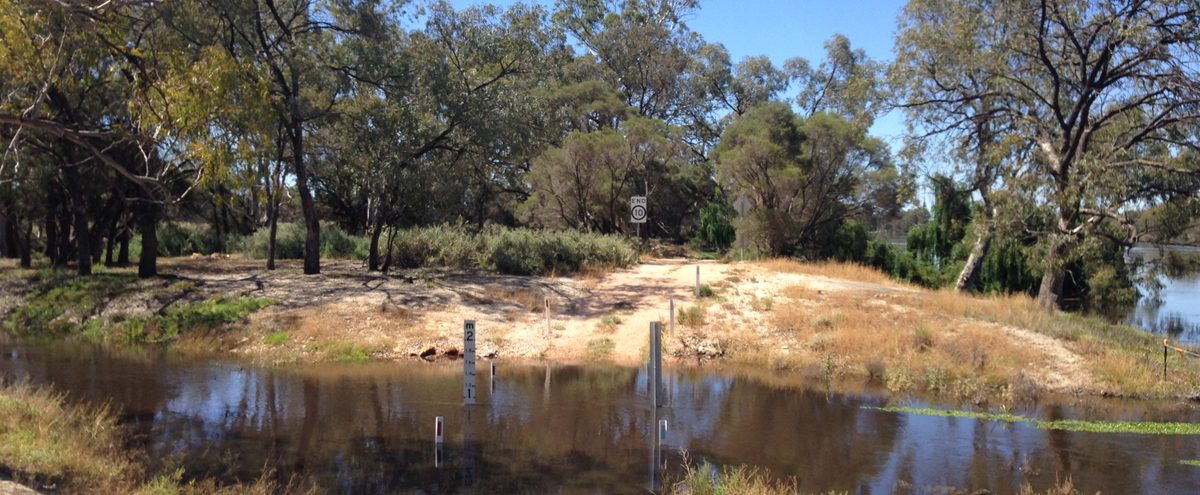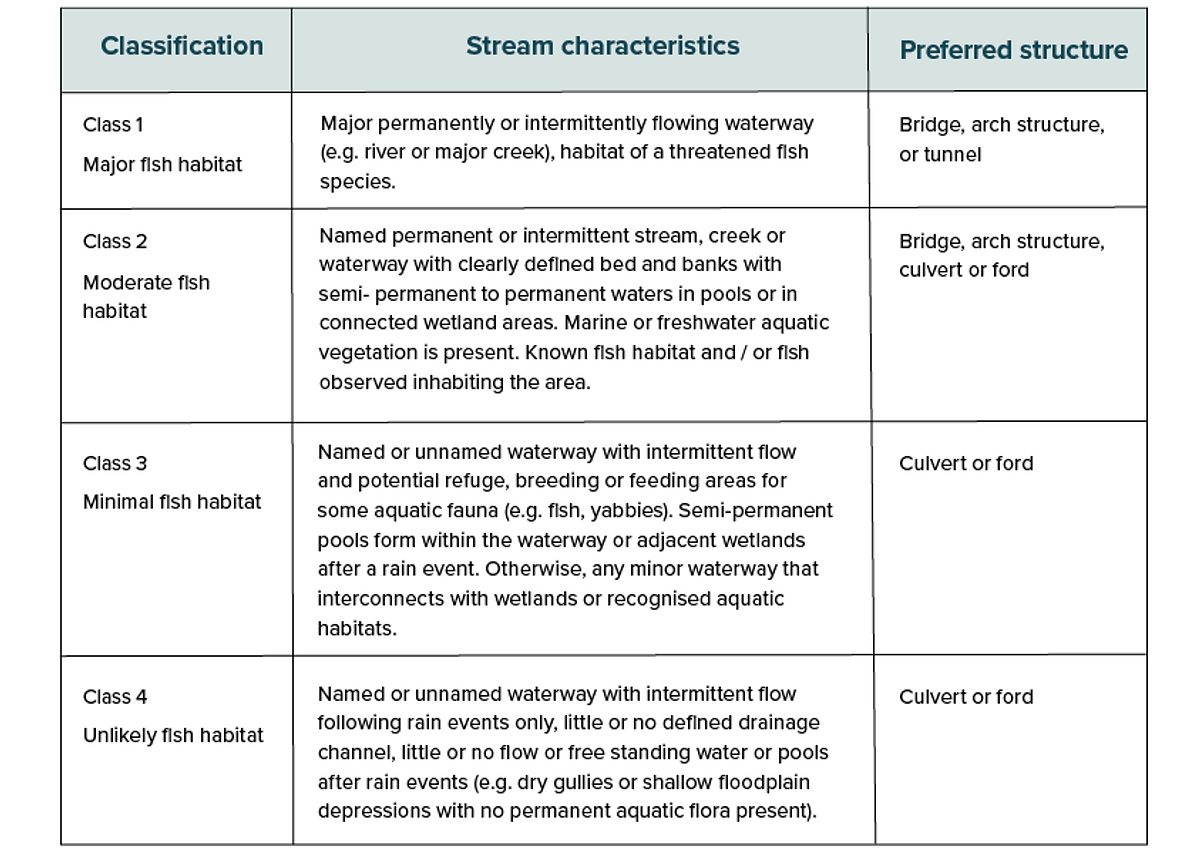
Building and maintaining fords
What is a ford crossing?
A ford is a shallow part of a natural or artificial stream channel, where people, vehicles or animals can cross with relative ease.
Ford crossings are the most environmentally friendly and least disruptive way to gain access across a waterway. This is because these types of crossings are constructed as close to the natural watercourse level as possible, with the bed and banks armoured with rock, grouted rock, cellular rock filled grids or concrete, to reduce the risk of erosion and possible failure of the ford.
There are many advantages to building a ford crossing instead of a causeway, culvert or bridge, including;
- a ford blends with the natural bed and bank profile so that the characteristics of the watercourse’s flow are preserved
- the more natural bed and bank profile means that fish passage up the watercourse is easier to accommodate in the design
- a reduced risk of watercourse blockage and flooding
- reduced maintenance following significant storm flows
- reduced risk of concentrating flows and therefore erosion downstream from the ford crossing.
Choosing your watercourse crossing
In choosing the right type of watercourse crossing for your property, give consideration to the watercourse’s characteristics. If the crossing will be located at a property’s main access point and the watercourse is prone to extended periods of flow that cannot be crossed using a light vehicle, you should consider constructing a causeway, culvert or bridge.
Ford crossing design
These guidelines provide advice on the minimum requirements and design considerations to successfully install a ford crossing.
Site selection
It is important to put the ford crossing on a stretch of watercourse that will result in the least construction cost, ongoing maintenance costs and environmental impact.
Consideration should be given to:
- Constructing the ford crossing in a straight stretch of the watercourse
- Ensure right-of-way exists
- Aligned perpendicular to stream flow / waterway
- Identifying a naturally rocky section of the watercourse, which will provide a more stable foundation for all-weather access
- The hydraulic effects of natural features (e.g. waterfalls) and artificial in-stream structures (e.g. weirs)
- Positioning the ford crossing at naturally high points (not in deep water) to reduce the impact on the watercourse
- The steepness of the banks and ability to maintain the watercourse’s natural banks without having to cut into them
- Fish passages and where to position the ford crossing to reduce any impact
- Ensuring the ford crossing is not placed in an area known to be habitat for local native fauna or flora
- Retaining existing trees and vegetation to minimise disturbance to the watercourse; this will also decrease the risk of generating new points of erosion
- Ensuring the geology of the ford crossing point is stable, that it has limited existing points of erosion, and that there is a low risk of long-term erosion or watercourse meandering that could damage the ford crossing.

Design considerations
When designing a ford crossing, think about:
- The type of traffic (animal or vehicle) likely to use the ford crossing and therefore the dimensions required (see below)
- Safety when ford crossing the watercourse during periods of flow
- Environmental impacts, including fish passage and erosion (see site selection)
- The intended life of the ford crossing
- The likely flow depth and velocity.
Ford crossing dimensions
The physical dimensions of the ford crossing depend on its intended use. The width of a ford crossing that caters for livestock may be different to that intended for farm machinery or light and heavy vehicles. A minimum width of 3 metres is typically recommended, but if the ford crossing is to be used when water is flowing over it, a minimum width of 4 metres is recommended to provide additional clearance for vehicles when the crossing is submerged.
Safety
Safety is an important design consideration. A ford crossing that is only used for stock and farm machinery may require lower-level safety considerations than a crossing that is used by light or heavy vehicles to access a property or one that is on a public road. A person unfamiliar with the ford crossing, and using it when water is flowing over it, may not have a sense of the depth of flow and could be at risk of being swept off the crossing. It is important to note that light vehicles become unstable in flood waters when the flow velocity is greater than 2.5 metres per second and flow depths are greater than 0.3 metres.
If the ford crossing is going to be used by the public or people unfamiliar with it, consider installing a depth gauge adjacent to the lowest point and signage with warnings to help them evaluate the risks of crossing.
Environmental considerations, design life and materials
From an environmental perspective, natural materials such as rock and gravels are preferred for constructing ford crossings.
Concrete will typically provide a longer life, however using concrete usually results in greater flow velocities across the ford crossing, making it more difficult for fish to swim across. Concrete structures can also be more expensive to construct and if not designed correctly, are prone to failure. If using concrete, it is recommended that the ford crossing is designed by an experienced engineer and includes measures to reduce the risk of undermining the concrete slab.
Concrete ford crossings should include a rounded depression (5 cm deep by 50 cm wide) in the lowest point of the watercourse so that fish can swim across the ford during times of low flow.
Flow depth and velocity
Flow depth and velocity are important design considerations. This information is not easily obtained for most rural watercourses and may need to be determined by an experienced civil engineer. In the absence of this data, you can use the following site observations to work out critical elements of the ford crossing:
- Identify the tops of the watercourse banks to work out the depth at full flow. This will help to determine the extent of rock or concrete protection required
- Identify the extent to which the approach road could be flooded during significant flows
- Is there rock or soil in the base of the creek? If rock, what is the size of the largest rock that has not been dislodged and washed downstream? If there are no small rocks (less than 100 millimetres in diameter) or gravels then the flow velocity at the ford crossing is likely to be in excess of 2 metres per second.
- If soil, is there any noticeable erosion?
Note that a watercourse with a soil base and little signs of erosion typically indicates that flow velocities are low and there may be an issue with sediment being deposited at the ford crossing, not erosion. A watercourse with an eroded soil base may indicate that flow velocities are greater than 1 metre per second and erosion is likely to be an issue.
Fish passage considerations

Construction materials and techniques
As previously mentioned, if using concrete it is recommended that the ford crossing is designed by an experienced engineer. If not designed properly, concrete ford crossings can fail, resulting in expensive replacement or repair costs.
If constructing a rock-lined ford crossing, the depth and size of rock to be used for moderate flow velocities is shown in table 2.
If the expected flow velocity is greater than that shown in table 2, consider finding an alternative ford crossing location. Small-sized rocks are used to lock larger rocks into position and reduce the risk of movement and loss of rock protection.
Rocks should be less than 400 millimetres in size and 90% should be greater than 150 millimetres. The thickness of the rock protection should be 500 millimetres, which is typically adequate for flow velocities up to 2.6 metres per second.
The rock should be hard, dense and durable. Rock that is laminated, fractured, porous, or otherwise physically weak should be avoided. A good guide to the ideal rock shape is that the breadth or thickness of a single rock should be not less than one third its length.
Rocks may be placed by dumping and spread by hand (for smaller rocks) and/or an excavator.

A geofabric liner should be placed under all rocks to protect from erosion and reduce the risk of the underlying soil being eroded.
A maximum gradient of the road, approaching the ford crossing, is recommended to be at 10%. Rock erosion control should extend 0.3 metres higher than the expected maximum water level and the ford crossing should not be raised greater than 100 mm above the base of the existing watercourse. The transition back to natural watercourse levels, on the upstream and downstream sides of the ford crossing, should extend a minimum of 1 metre up and downstream of the ford crossing to tie in with the existing watercourse level.
The width of the ford crossing will need to be excavated to suit the depth of rock protection and a geofabric liner installed at the base of the excavation. Regardless of whether rock or concrete is used in the construction of a ford crossing, the points of weakness, with respect to erosion, are typically at the interface between the new and existing materials. It is important that significant level changes and holes at these interfaces are avoided. If a relatively smooth running surface is required over the ford crossing, a finer gravel material or cement-stabilised pavement material can be laid on top of the rock protection.
Depending on flow velocities, this finer material may be more susceptible to erosion and require more maintenance after significant flow events. To reduce ongoing maintenance, the finer material should be used to fill existing holes created by larger rocks and should not be constructed as a layer over the top of the rock protection.



Maintenance
If using rock to line the ford crossing, it is advisable to keep a stockpile of rocks near the site for future maintenance. Similarly, finer material used to create a smoother running surface could also be kept near the site.
Ford crossings should be inspected after each significant flow event and if there is any erosion, repair these sections to reduce the risk of more substantial damage. The ford crossing should also be inspected during low flows to ensure fish can swim over it.

Disclaimer
All landholders using this information do so at their own risk and are encouraged to seek engineering advice. While every reasonable effort has been made to verify the information in this guide, use of the information contained is at your sole risk. The Murraylands and Riverland Landscape Board recommends that you independently verify the information before taking any action.
This webpage is based on information developed by Landscapes Hills and Fleurieu and republished with permission.